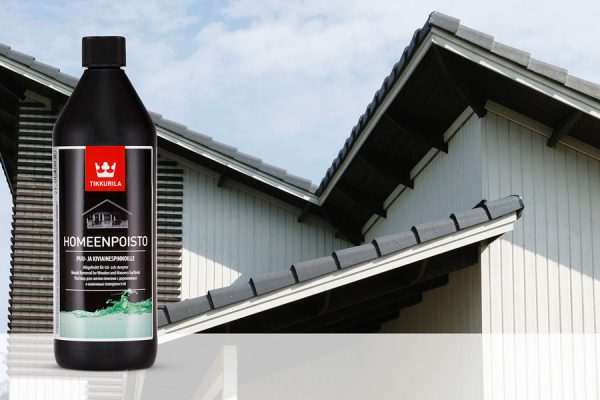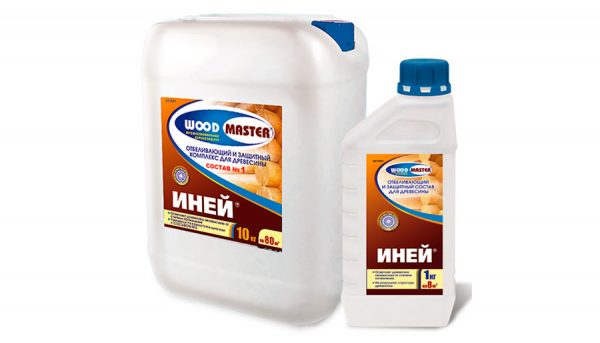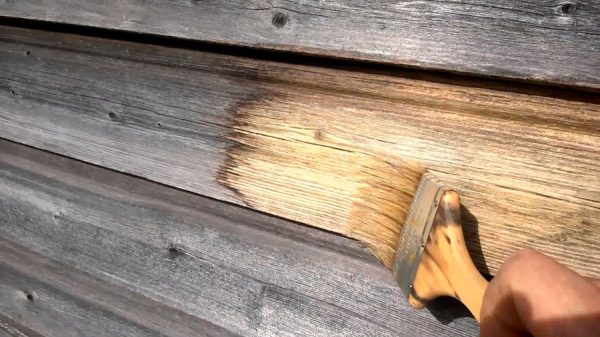Often during long-term use, a wooden floor or other coatings made of wood lose their attractiveness - they begin to turn blue, blacken. This happens if the wood is not periodically treated with special means that protect against fungus. You can correct the situation even with a problem that has already appeared. You need to purchase a bleach for wood and apply it in accordance with the instructions.
- Why bleach wood - the reasons
- Why does a tree change its natural color?
- Best bleaches
- Neomid 500
- Senezh Effo
- Homeenpoisto
- Sagus
- Fongifluid Alpa
- Prosept 50
- Woodmaster Frost
- Folk remedies for whitening
- Chlorine-based bleaching agents
- Hydrogen peroxide whitening
- Calcium Hypochlorite Treatment
- Oxalic acid clarification
- Necessary tools and materials
- Whitening instruction
- Home Whitening Tips
- Caution in working with bleach for wood

Why bleach wood - the reasons
Darkened, unevenly painted wood spoils the appearance of the building or coating. Usually the first sign of an impending problem is blue spots that grow and merge with each other. If you do not take the necessary measures, black and greenish stains are formed - the mold will actively multiply on the wood. Wood-coloring mushrooms not only worsen aesthetics, but also harm the structure of the material. They make the tree more susceptible to the work of wood-destroying fungi, which are not easy to destroy.
An effective method of combating microorganisms is whitening. Usually it is carried out for the following reasons:
- if the tree is not timely treated with a protective compound;
- to repair damaged areas;
- to conceal small defects;
- to create one color gamut of the coating, which consists of different types of wood.
Whitening helps against blackness, because all the tools used are antiseptics and destroy mold, rot, biodeterioration, and darkening. Usually bleaches are effective against bacteria, fungi, insects. Nevertheless, the bleached tree will be etched only on the surface (up to 3-5 mm) - most products do not penetrate inside, therefore, for the prevention of blackening, it is better to use fungicidal solutions in time.
to contents ↑Why does a tree change its natural color?
Wood is an organic material, it is attractive to many pests, microbes, fungi. Typically, the reproduction of these microorganisms begins with high humidity, constantly high air temperature. In some cases, lichen or moss may even appear on the surface of the wooden floor. Most often, black spots affect wood in the bathhouse, where there are all conditions for the reproduction of mushrooms.
It happens that a tree turns black or blue for other reasons:
- improper transportation of logs, lumber;
- violation of storage conditions (in a damp, unventilated place);
- rainfall;
- long exposure to direct sunlight.
Fungus, mold can settle on absolutely any material, regardless of the type of wood. Even on the glued beam, despite chemical impregnation, microbes settle, as well as on the imitation of the beam.The color of wood can change in different ways, here the breed matters. So, the oak gains “gilding”, the birch turns blue spots, the dark ash, on the contrary, brightens, the nut becomes bright red. You need to learn how to bleach a tree at an early stage of its defeat by fungi, otherwise it will not work out completely.
to contents ↑Best bleaches
Bleach - a chemical agent with a specific composition that can lighten wood. Of course, such solutions cannot give an absolutely white color, but they can do the removal of all stains caused by mold or sunlight. The whitening effect is achieved due to the oxidation of chemicals and their effects on the pigment of wood. In addition, the presence of antiseptic additives allows you to completely destroy the fungi that managed to spread through the material.
The market has a lot of tools for bleaching lumber at home. Experienced wood craftsmen are advised to choose a quality product for exterior or interior use that works safely and does not damage the wood structure. Before work, you must carefully read the instructions - some formulations help only in the very initial stages of fungal infection, others successfully work even with a strong blackening of the wood.
Which is better to choose bleach? Most of the funds sold in stores have a similar composition. There are two main groups:
- with chlorine;
- with hydrogen peroxide.
Both types of compounds belong to the second hazard class. Peroxide-based bleaches are considered safer, although they cannot be called completely harmless. In any case, a chemical process takes place in the upper layers of the wood; evaporation is released into the environment. Chlorine bleaches contain dilute chlorine alkali, and those based on hydrogen peroxide also include alkali or weak acid as additives. The most popular bleach brands are described below.
to contents ↑Neomid 500
Neomid wood bleaching agent is used not only to improve the color of the material, but also to disinfect it. The solution can be used to improve the appearance of wood in the interior of the premises, as well as for work on the street. "Neomid 500" restores the natural shade of the tree, increases its grade, while not changing the texture and properties. You can use the tool to process fuel granules to increase the shelf life, because it easily removes all fungi and microbes.
The advantages of the composition are:
- low price and excellent quality;
- safety and ease of application;
- suitability for all types of wood;
- the presence of different packaging on sale.
Senezh Effo
This bleach is especially recommended for lightening wood that has lost color due to exposure to ultraviolet light. Also, the product is suitable for treating wood against stains caused by a fungus or the influence of atmospheric factors. Senezh Effo copes with fungal deposits of any severity, up to a deep damage to the wood (up to 5 mm). It is suitable for solid, chopped, planed lumber, as well as for combined finishing materials.
It is only important that the wood is not exposed to paint before applying bleach.
"Senezh Effo" is based on hydrogen peroxide and has the following advantages:
- does not contain chlorine;
- withstands long storage and freezing;
- in contact with skin does not provoke chemical burns;
- removes all forms of organic pollution;
- not dangerous for humans, animals;
- has a pleasant aroma;
- safe regarding the risk of fire.
Homeenpoisto
This Finnish-made hypochlorite solution from Tikkurila is used to eliminate mold from wooden substrates. The composition of powerful components - sodium hypochlorite, sodium hydroxide. Substances are rather caustic, aggressive, require great care when performing work.
In addition to painted and unpainted wood, this bleach is suitable against mold on such surfaces:
- plastered;
- concrete;
- tiled;
- fiber cement.
The tool perfectly removes the blue if it did not have time to penetrate deep into the wood. It has a jelly-like consistency, therefore, before use it is diluted with water 1: 3, which seriously reduces consumption. You can apply the finished solution with your own hands using a spray gun, sponge, brush.
to contents ↑Sagus
Sagus bleach is suitable for removing stains from wood inside and out. It can be used on any type of lumber, on solid wood. The solution will remove the darkening of various origins - from long use, exposure to the sun, rain. Also, "Sagus" will destroy any microbes, fungi and larvae of insects that settle in the wood.
The composition penetrates deep into the structure of the tree, highly effective, does not lose its properties when frozen, does not cause damage to the tree, meets fire safety requirements. It is sold in small packages and large cans (up to 10 liters).
to contents ↑Fongifluid Alpa
The product is produced in Russia according to French technology, has a very high quality. It is used to prevent wood damage by fungus, to destroy existing mold, as well as to eliminate areas of darkening, blueing, yellowing of wood. Also, the drug is used to destroy moss, lichen, insects and bacteria outside and indoors. According to reviews, “Fongifluid Alpha” copes with the most persistent pollution well, therefore, despite the high price, it is very popular. Bleach is suitable for use against mold and mildew on the following materials:
- roof tile;
- ceramics;
- natural stone.
After application, Fongifluid Alpha creates a strong film that protects the wood for at least 2 years. Among other things, the composition increases the adhesion ability of the tree, after it the paints and other paints and coatings go better and last longer.
to contents ↑Prosept 50
PROSEPT 50 is a highly effective bleach, which is a chlorine-containing composition of active substances. Chlorine penetrates the surface layers of wood (up to 3 mm), restoring its normal color and without damaging the fibers. Here are the main properties and characteristics of the solution:
- has an economical expense and low price;
- quickly removes all types of contaminants, wood-coloring mushrooms, gray plaque, mold, blue;
- suitable for all types of wood;
- can be used for processing wooden containers, pallets, which are used in the transportation and storage of products;
- differs in high speed of action (only 20-30 minutes), rapid degradability (12 hours at +20 degrees).
After the final decomposition of the active substances, wood products can be subjected to mechanical and thermal processing, gluing, impregnation, staining.
to contents ↑Woodmaster Frost
The Hoarfrost preparation based on sodium hypochlorite helps restore the appearance of wood, which has darkened as a result of exposure to wood-staining, wood-destroying, mold fungi, algae, moss, and also bacteria. It is used outdoors and indoors. “Hoarfrost” works at any depth of damage, not only on wood, but also on such surfaces:
- brick;
- concrete;
- roof tile;
- plaster;
- tile;
- a rock.
The tool significantly improves the appearance of the tree, increases the grade, while not destroying the structure and does not interfere with the natural breathing ability of the material. Bleach does not impair the strength, tintability, and adhesion of wood. It provides antiseptic processing of materials before coating with protective compounds.
to contents ↑Folk remedies for whitening
Despite the existence of a large assortment of professional products, many are trying to save money and use homemade compounds for bleaching wood. From the photo on the Internet you can see that the result is not always good, often the material deteriorates, bleaches unevenly. Nevertheless, for insignificant surfaces, you can use alternative methods, having previously tried them on an inconspicuous area. Some just wipe the tree with "White", but it is better to use combined means.
to contents ↑Chlorine-based bleaching agents
Before applying chlorine or in parallel with the main stage, it is necessary to treat the base with soda ash or potassium carbonate. This will help to remove resinous substances and prepare the wood for further finishing.
The procedure will be as follows:
- pour 10 liters of water into the container;
- dilute in water 2 kg of bleach, 0.25 kg of soda ash;
- mix, leave to settle;
- drain the solution, apply to wood;
- after 5 minutes, wipe the surface with vinegar (4-9%).
Usually the tree is lightened after 15 minutes, but for a very darkened material, processing should be carried out twice. Products of the most neglected form are best placed in a solution for 30 minutes. Before painting, the wood must be washed with soapy water.
to contents ↑Hydrogen peroxide whitening
The usual pharmacy hydrogen peroxide is not suitable for wood processing, here you need a concentrated solution - perhydrol. It is applied in its pure form to the products with a sponge, after 15-20 minutes neutralization is carried out with vinegar (4%). Pre-moisten the base with water, then apply a solution of ammonia 10%. Do not use this method on oak surfaces - they can turn green. Ideal peroxide for beech, birch, walnut.
to contents ↑Calcium Hypochlorite Treatment
Wood processing is performed with diluted 8: 100 calcium hypochlorite. The solution should be applied with a sponge to the wood, after 5 minutes, wipe with 2% acetic acid. After 20-30 minutes, the product will gain a more attractive shade.
Oxalic acid clarification
This acid is best suited for lightening maple, linden, poplar, birch. It is necessary to take 5 ml of the substance, dilute in 100 ml of water, apply to wood. If more powerful and faster whitening is required, a solution is prepared from equal parts of oxalic and sulfuric acid, sodium peroxide (2.5 mg per 5 ml of acid) is added.
After reaching the desired color, it is necessary to neutralize. To do this, dilute in 100 ml of water 15 g of bleach, 3 g of soda ash. First, soda is dissolved in hot water, and lime is added after cooling. The solution is applied to the wood, after an hour it is washed off with plain water.
to contents ↑Necessary tools and materials
To work, you need to prepare the actual bleach, gloves, water, a container for diluting the drug, brushes, sponges for applying. Also, a spray can be used to irrigate wood with a solution.
to contents ↑Whitening instruction
Before bleaching, the wood should be sanded, remove visually noticeable dirt (if possible), and get rid of large irregularities. This will help the composition act more evenly and more effectively penetrate between the fibers of the material.
It is important to protect all glass, aluminum surfaces from bleach.
The solution is diluted with water or used in finished form - this is indicated in the instructions. The composition is applied with any device that is more convenient to work with. Usually a large foam sponge, soft brush is used for this purpose. If the base is large in size, it is easier to apply the composition from the garden sprayer in stripes from bottom to top.
After 30 minutes (for some products, the time is different), the solution can be washed off.Moldy areas should be treated with a stiff brush or metal spatula. Flush the surface from top to bottom from a hose or sprayer.
to contents ↑Home Whitening Tips
Any preparation or self-made product should be thoroughly washed off after completion of the action. Acid compounds are removed with a solution of soda ash, and baking soda dissolved in water can also be used. You cannot mix different bleaches with each other - the result is unpredictable. Glued products can be processed only by those means in the instructions to which there is an indication of such a possibility.
to contents ↑
Caution in working with bleach for wood
Avoid contact with clothing, as soon as bleached stains remain on the fabric. Work should be in overalls or one that is not a pity to throw away. It is imperative to use glasses, a respirator, gloves, and provide good ventilation in the room.
If it comes into contact with the skin, it is necessary to rinse thoroughly with water, if the composition penetrates the eyes, they are also washed and immediately consult a doctor! Store bleach in its original packaging in a dark place, out of the reach of children and animals. All tools are washed with water after work.



















